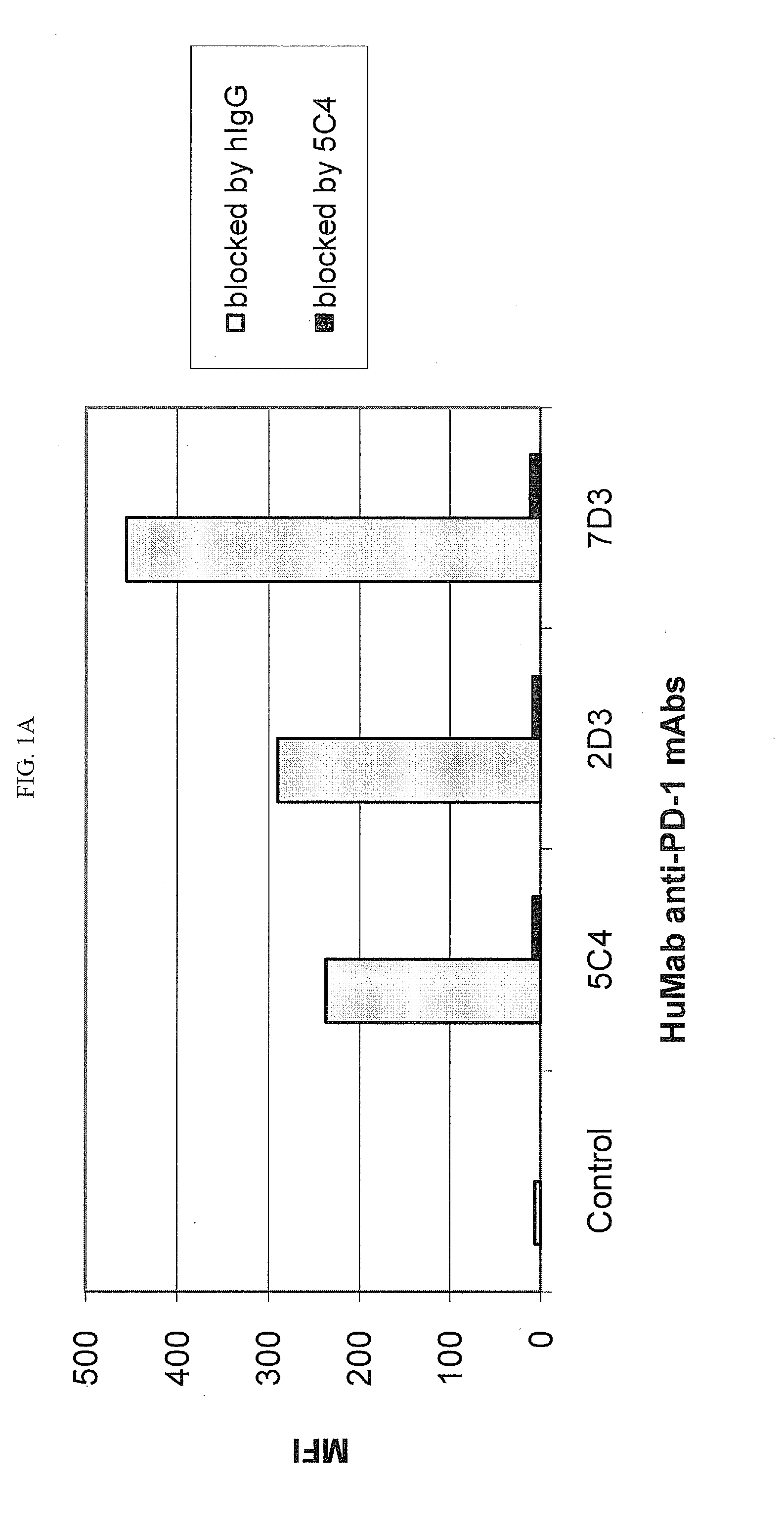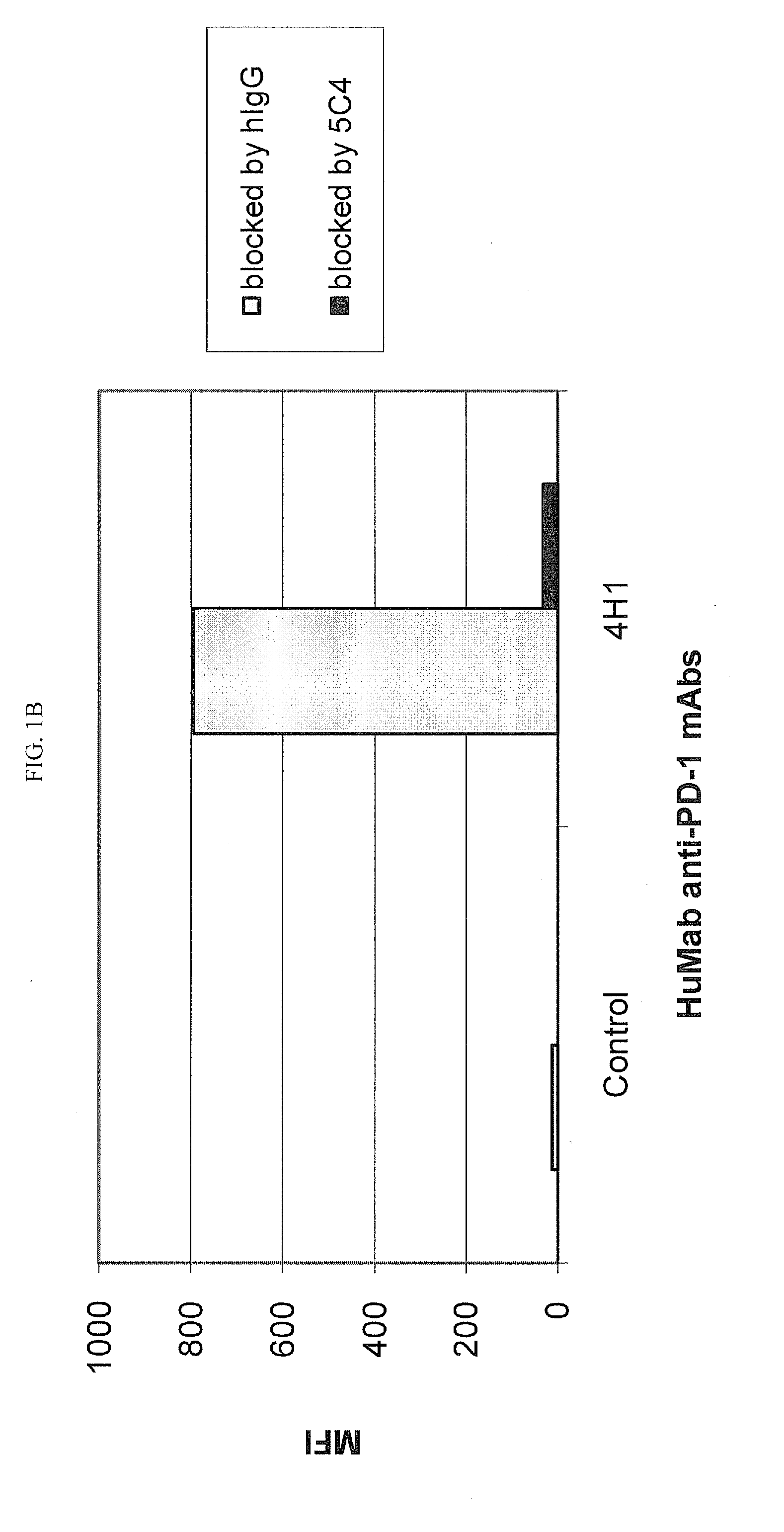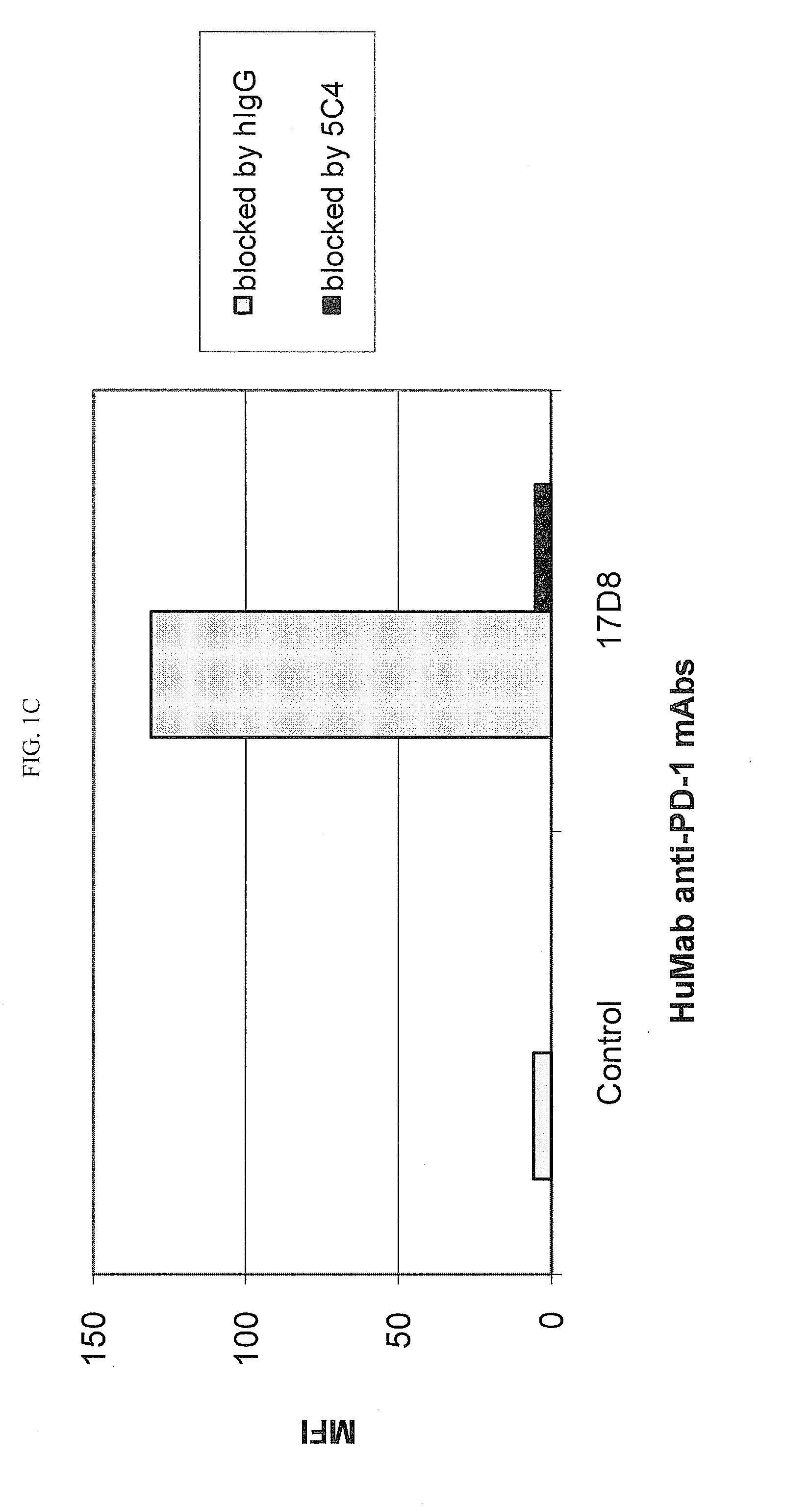Cancer immunotherapy by disrupting pd-1/pd-l1 signaling
a cancer immunotherapy and signaling technology, applied in the field of cancer immunotherapy by disrupting pd1/pdl1 signaling, can solve the problem of ineffective response, and achieve the effect of reducing or suppressing signaling and durable clinical respons
- Summary
- Abstract
- Description
- Claims
- Application Information
AI Technical Summary
Benefits of technology
Problems solved by technology
Method used
Image
Examples
example 1
Cross-Competition Between Anti-PD-1 HuMAbs for Binding to CHO Cells Expressing Human PD-1
[0218]Chinese Hamster Ovary (CHO) cells transfected to express human PD-1 (CHO / PD-1 cells) were incubated with 10 μg / ml of Fab fragment of the anti-PD-1 HuMAb 5C4 or human IgG1 (hIgG1) isotype control Ab for 30 minutes at 4° C. before addition of anti-PD-1 HuMAbs 2D3, 7D3 or 4H1 at a concentration of 0.2 μg / ml. Binding of 4H1, 2D3 or 7D3 to CHO / PD-1 cells were detected by fluorescein isothiocyanate (FITC)-conjugated goat anti-hIgG, Fc-gamma specific Ab. In the case of cross-competition assay with 5C4 and 17D8, CHO / PD-1 cells were incubated with the whole molecule of 5C4 before addition of FITC-labeled 17D8. Binding of 2D3, 7D3, 4H1 or 17D8 to the CHO / PD-1 cells was measured by flow cytometric analysis using a FACS® calibur flow cytometer (Becton Dickinson, San Jose, Calif.).
[0219]The results are depicted in FIG. 1. The data show that the 5C4 Fab fragment substantially blocked the binding of mAbs...
example 2
Cross-Competition Between Anti-PD-L1 HuMAbs for Binding to CHO Cells Expressing Human PD-L1
[0220]CHO cells transfected to express hPD-L1 (CHO / PD-L1 cells) were incubated with 10 μg / ml of each of ten unconjugated human anti-PD-L1 mAbs (5F8, 7H1, 10H10, 1B12, 3G10, 10A5, 11E6, 12A4, 12B7, and 13G4) or human IgG1 (hIgG1) isotype control Ab for 20 min at 4° C. FITC-conjugated 10H10 (A), 3G10 (B), 10A5 (C), 11E6 (D), 12A4 (E) or 13G4 (F) was added to the cells to a final concentration of 0.09 μg / ml (B, D), 0.27 μg / ml (A, C), 0.91 μg / ml (F), or 2.73 μg / ml (E) for an additional 20 min at 4° C. without prior washout of unbound, unconjugated Ab. Different quantities of the various FITC-conjugated HuMAbs were used due to differences in binding efficiency following labeling, and the optimal amounts of these FITC-conjugated HuMAbs were previously determined by dose-titration analysis of binding to CHO / PD-L1 cells. Binding of FITC-conjugated 10H10, 3G10, 10A5, 11E6, 12A4 or 13G4 to the CHO / PD-L1...
example 3
Cross-Competition Between Anti-PD-L1 mAbs for Binding to Ovarian Carcinoma Cells Expressing Human PD-L1
[0222]Anti-PD-L1 HuMAbs 5F8, 12B7, 3G10, 1B12, 13G4, 10H10, 10A5 and 12A4, and a human IgG1 (huIgG1) isotype control Ab were serially diluted from 10 ng / ml and incubated with hPD-L1-expressing ES-2 ovarian carcinoma cells for 20 minutes at 4° C. Without washing, biotinylated-12A4 Ab was added to a final concentration of 0.4 ng / ml for an additional 20 minutes at 4° C. After washing, bound biotin-12A4 was detected using fluorescent streptavidin-PE secondary reagent and measured by flow cytometry. FIG. 3 shows the fluorescence of bound biotin-12A4 plotted against the concentration of unlabeled hPD-L1 HuMAbs. Binding of biotin-12A4 to ES-2 cells was substantially blocked by 12A4 itself and by 1B12 and 12B7, and was moderately to significantly blocked by mAbs 5F8, 10A5, 13G4 and 3G10, but was not blocked by mAb 10H10.
PUM
| Property | Measurement | Unit |
|---|---|---|
| threshold | aaaaa | aaaaa |
| threshold | aaaaa | aaaaa |
| concentration | aaaaa | aaaaa |
Abstract
Description
Claims
Application Information
 Login to View More
Login to View More - R&D
- Intellectual Property
- Life Sciences
- Materials
- Tech Scout
- Unparalleled Data Quality
- Higher Quality Content
- 60% Fewer Hallucinations
Browse by: Latest US Patents, China's latest patents, Technical Efficacy Thesaurus, Application Domain, Technology Topic, Popular Technical Reports.
© 2025 PatSnap. All rights reserved.Legal|Privacy policy|Modern Slavery Act Transparency Statement|Sitemap|About US| Contact US: help@patsnap.com



